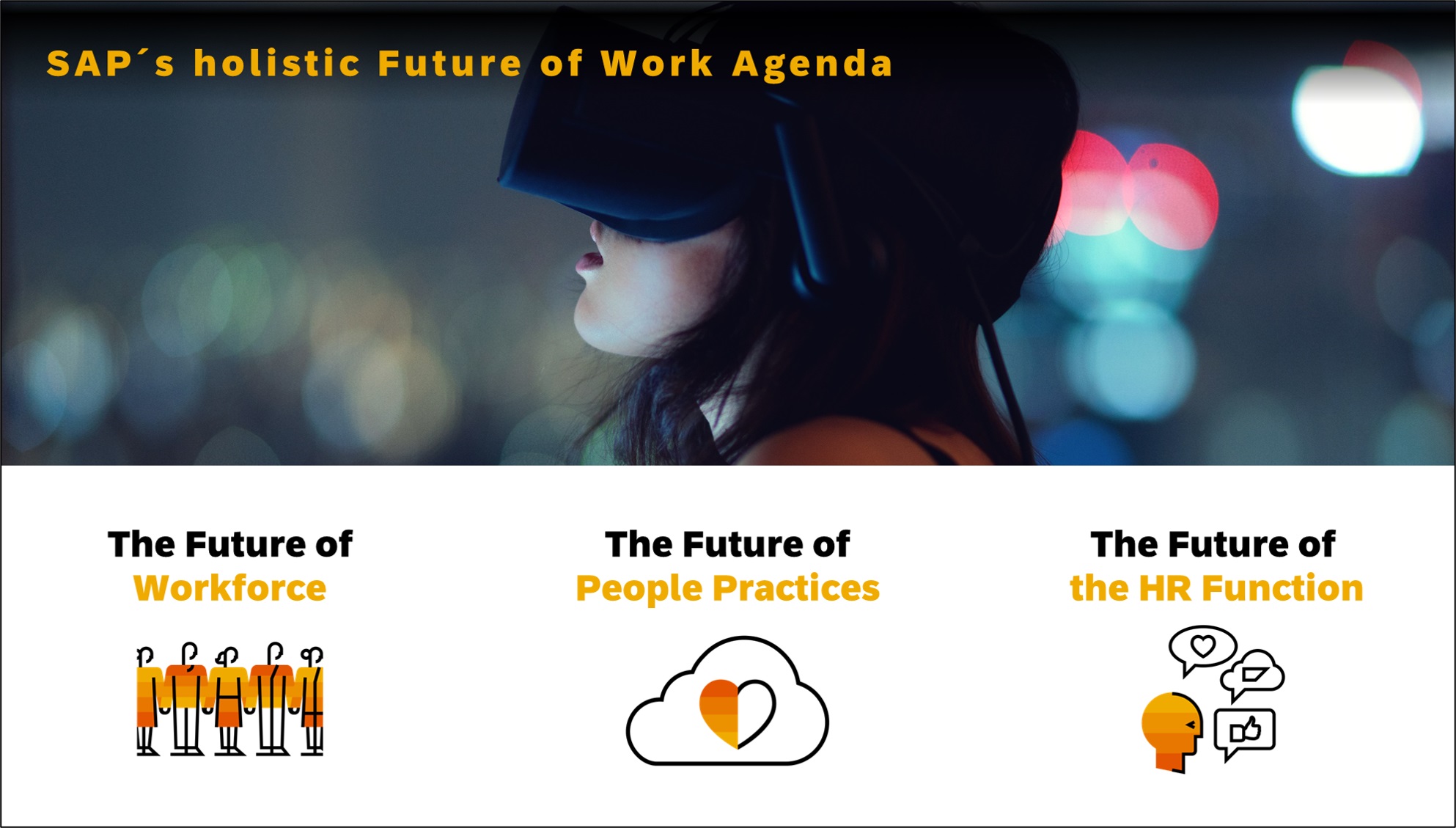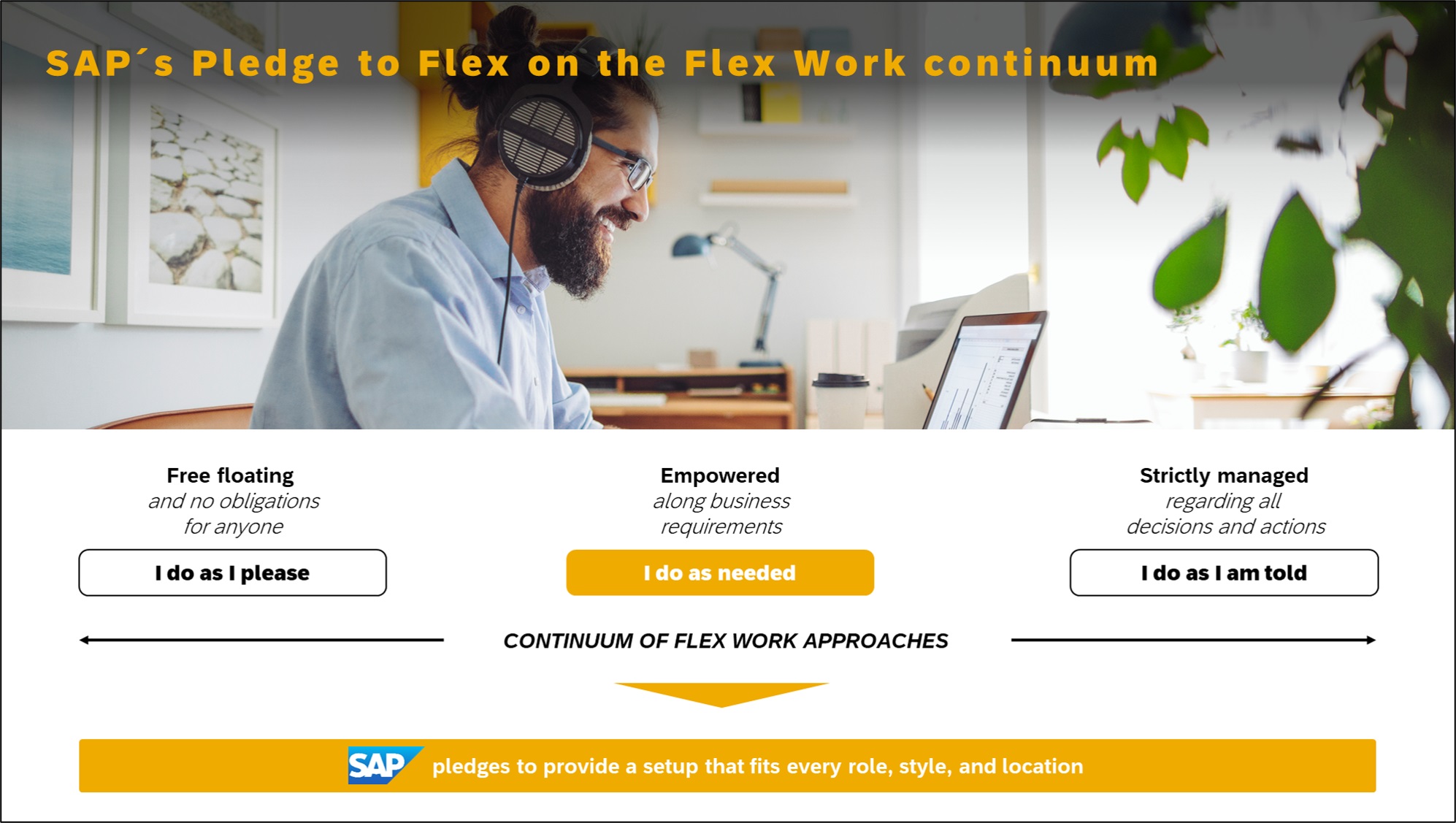For many, the introduction into a new world of work was driven by a focus on employee safety and business continuity in response to the pandemic. As we move forward into a post-pandemic era, organizations can finally shift their focus from crisis management to strategically thinking about the future of work. Now is the time to switch gears.
It’s the heyday of flex-work models, but the future of work is so much more, with opportunities ready to be tackled along the spectrum of workforce transformation, new people practices, and next-generation HR models.
SAP’s Holistic Future of Work Agenda: Shaping the Next World of Work
Managing the future of work holistically is a strategic imperative to build a resilient, agile, and innovative organization that is future-fit for the digital age. As global provider of leading-edge human experience management (HXM) software, SAP has been putting its focus on designing a holistic future of work agenda that empowers its more than 100,000 people across the globe to thrive while creating value for its customers.
The agenda is SAP’s north star to reimagine work at its core. It considers business elements and strategic HR components along three dimensions to create a sustainable work experience for its global and diverse workforce:
- Future of Workforce, aiming to define a target picture for a future-proof workforce at SAP
- Future of People Practices, making new, flexible, and healthy work “work” for everyone
- Future of HR, reimagining the way how HR functions need to operate in future along a strategic HR master plan

Future-Proof the Workforce
Accelerated digitalization and technology advances fuel the need for skill transformations across large portions of today’s workforce. The shift of skills as well as demographic changes result in a shortage of available talent, emphasizing the necessity of a clear understanding of future workforce demands. At the same time, this increases the competition for available talent in the market.
SAP’s workforce transformation is based on scenario modeling to provide a clear understanding of what our workforce will need to look like five to 10 years down the road and how it will be composed. From these projections, we can derive a strategy to define the target picture with the right mix of permanent employees, gig workers, as well as the use of technology and artificial intelligence (AI). HR leaders play a crucial role by engaging in systematic resource planning in line with business strategy requirements.
To future-proof their workforce, organizations need to prioritize continuous employee development through up- and reskilling. One example of this commitment is SAP’s internal talent marketplace, which offers project work, fellowships, or mentoring opportunities. Employees can take on respective assignments and apply their expertise where it is most needed while also acquiring new skills on the job: a win-win for everybody.
Leading-Edge People Practices
People are the heartbeat of every organization. To meet ever-changing employee needs, organizations need to create innovative and effective strategies to attract, develop, engage, and retain top talent, as well as constantly challenge and evolve their people and workplace practices.
Empowerment Through Flexibility
Flexibility is in more demand than ever, making it a strong lever for outstanding employee experience. With Pledge to Flex, SAP offers a hybrid work model that empowers employees to decide with their managers when, where, and how they work best in alignment with customer and business requirements.
There is measurable success to the advantages of flexibility: SAP’s recent global future of work pulse survey revealed that over 80% of the workforce feel at least as or even more productive, satisfied, and engaged through hybrid work. The grand majority also believes that flexibility increases SAP’s attractiveness as employer.

Providing the best setup for every team with the right balance between office and remote work is one of the key elements in making hybrid work “work” for everyone. At the same time, the office remains the number one place to meet and support cultural affiliation, networking, and onboarding of new joiners.
To promote SAP’s hybrid work approach with Pledge to Flex, we launched the internal “I’m In” campaign, encouraging employees to find the right ratio of in-office and remote work. At SAP, we see that a combination of splitting time between remote work and two to three days of in-person office work per week seems to be a good practice, given that it fosters team spirit, engagement, and excitement about the organization.
Enablement for a Successful Transition
To navigate the added level of complexity in a hybrid landscape and build a routine, enablement and trainings are key. SAP supports employees, managers, and teams with hands-on tools and resources to balance team and individual needs while keeping customer requirements front and center.
One example is the Flex Team Workshop, allowing leaders and team members to jointly determine the hybrid work setup that best fits their needs in terms of productivity, collaboration, work-life balance, and, of course, business and customer requirements. Additionally, the Meeting Workout toolkit is a gamified approach to review and declutter meetings, making each interaction more valuable to everyone. And with “Lighten the Load” and “Are you OK?,” SAP runs powerful personalized programs to enhance employee health and people sustainability, while providing stress relief.
Leadership becomes more demanding in the new world of work. Leaders need to become even stronger facilitators when communicating direction and strategy in a hybrid environment. Critical skills to adjust to the evolving role of management include communicating and listening with empathy and being agile when connecting with people. Modern leadership today also includes to keep teams engaged and tackle Zoom fatigue in times of unprecedented change.
Next-Generation HR
A data-driven and agile HR approach is the foundation to bringing the future of workforce and people practices to life. With the help of leading-edge technology, the HR function can evolve while addressing the demand for scalable and flexible services to meet changing needs of employee and the business quickly and efficiently.
Besides technological advancements, the required skills for the future HR function will evolve as well. SAP focuses on a set of key themes:
- Experience management in HR, emphasizing the needs of employees, managers, or applicants from a HR consumer point of view
- Data-driven HR, leveraging advanced analytics to solve talent and organization related business problems and support decision-making
- Digital HR to reap the fruits of technological advances across the entire employee life cycle
- Agile HR, applying an agile mindset, values, principles, practices, and tools when serving the business
Capabilities like digital savviness, analytical skills, data interpretation, and an agile mindset will become must-have skills for successful HR work in the new era.
Stay Curious and Keep Learning
Looking ahead, it is fair to say that we are just scratching the surface when it comes to the many opportunities to shape the future of work. With an industry-leading hybrid work model in place, SAP built a strong foundation to tackle the workplace evolution as part of a holistic future of work agenda.
Getting the triad of future workforce planning, people practices, and next generation HR teams right sets the path to make organizations more future-ready while the world around us is changing at breakneck speed. In the end it all comes down to continuously learning and discovering what works best for the creation of outstanding employee experiences while driving sustainable business success — truly exciting times for HR!
Dr. Christian Schmeichel is chief future of work officer at SAP.



